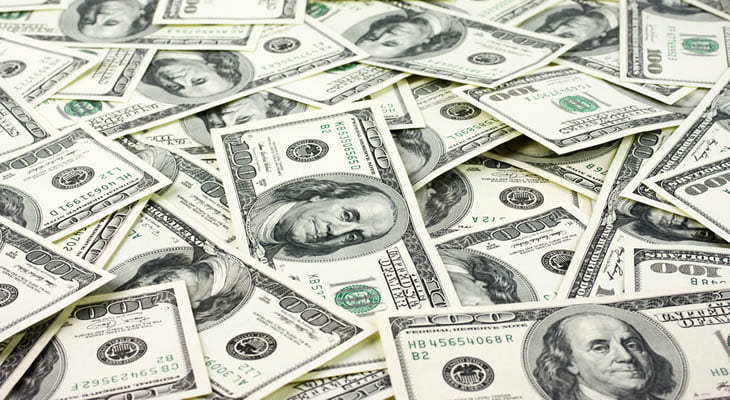We all know that the dollar is the currency in the United States, the Pound is currency in the United Kingdom, Peso is used in Mexico for payments and that Scandinavian countries use a currency that is derived from the word “crown” (Krone in Norway, Krona in Sweden and so on). But have you ever asked the question “how these currencies got their names”? If you haven’t it might be time to ask it. If you have, we have the answer thanks to Oxford Dictionary section.
Dollar
The United States are not the only country with the “dollar”. In fact, Canada, Australia, Singapore, New Zealand and Fiji have their own version of the dollar. A Canadian dollar, for example, is worth less than the US dollar. All of this makes the dollar one of the most common currencies, rivaled only by the Euro (which one can say is an artificial currency created by the European Union). The origin of the word lies in a coin that was once called “the Joachimsthaler”. The name was then shortened to Thaler (daler in Low German). The coin was named after a valley in which miners mined the silver for the production of the coin, or Joachim’s valley. The name eventually morphed into dollar, and in 1792, the word became the name of the US monetary unit.
Rupee
India and Pakistan have their rupee. And their currency is a literal example that not all that glitters is gold. The rupee got its name from the word “rupya”, a Sanskrit word used to describe “wrong silver”. The currency in Indonesia, rupiah also derives from the word “rupya”.
Lira
The Lira is still the official monetary unit in Turkey, and before the euro, the lira was used in Italy as well. The monetary unit got its name thanks to a Latin word. The word is “libra”, and the translation is “pound”. When you think of it, Britain has its pound, but many other currencies strive for the same name.
Peso
It is no secret that many things in Mexico were influenced by the Spaniards. In fact, “Mexican Spanish” is a variety of the Spanish language spoken in Mexico. The currency of Mexico, Peso, also comes from a Spanish word. When translated literally, Peso means “weight” in Spanish. The peso is also used in Chile, Uruguay, Cuba, Colombia, Argentina and the Philippines.
Rand
You’ll notice that many of the currencies got their name according to the valley the coins were mined. The rand, a South Africa monetary unit got its name from the name of the city Witwatersrand. The currency got the name from the Dutch name for the city. Like you would expect, the area is rich in gold mines.
Crown
As we mentioned at the beginning, many of the Scandinavian countries use a name that is derived from the word “crown”. Norway, Sweden, Denmark and others use the Latin name for crown, which is “corona”. Therefore, you have krone in Norway, krona in Sweden, krone in Denmark, kroon in Estonia (now euro), krona in Iceland and even koruna in the Czech Republic.
Yuan, Yen, Won
China, Japan, and Korea are three Asian countries that share a rich history together. They also share the origin of their national currency. The Chinese yuan, yen in Japan and won in Korea all got their name from the character “圓”, meaning “round, round coin” in the Chinese language.
Ruble
Russians also used a word for weight for their national currency. The ruble was a measure of weight, which Russians used to use for measuring silver.
Pound
![]()
The pound might be most famous for its usage in the United Kingdom, but Egypt, Sudan, Syria, and Lebanon also call their currency pound. The name comes from the Latin word “pondus”, which translates to “weight. The sterling in the British currency comes from the early Norman coins, meaning “little star”. The early Norman coins all had a star on them.
Rial
Iran has its Rial, a currency Spain used as well before the transition to Euro. Yemen, Qatar, and Saudi Arabia also use a currency that is close, called “the riyal”. The origin is the same, and you can look for it in the Latin word “regalis” which translates to “royal”.
Dinar
The Dinar was widely used in Yugoslavia, and ever since the country disbanded, Serbia was the only one to continue using the dinar currency. Kuwait, Algeria, and Jordan are other countries in the world that use dinar. The dinar is derived from the Latin word “denarius”, which was actually a silver coin originally used in Ancient Rome.
Forint
Hungary became part of the European Union in 2004, but the country still uses its national currency forint. The euro can be used in Hungary as well, but the country’s national currency is forint, which originates from the word “fiorino”, an Italian word used to describe gold coin from Florence. The coin had a flower stamped on it.
Ringgit
Malaysia uses ringgit, a monetary unit that got its name thanks to thieves. Back when coins were minted in metals, they were an easy target for thieves, as they would usually shave off some portions of the metal. Thieves used this method to create new coins. To protect themselves and their coins, countries minted their coins with jagged edges. Ringgit is the Malaysian word for “jagged”, therefore the currency’s name.



